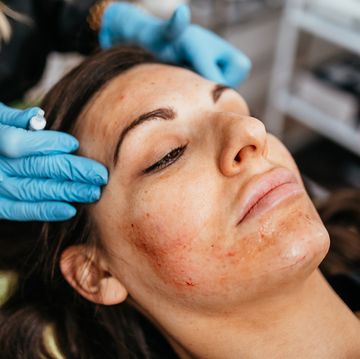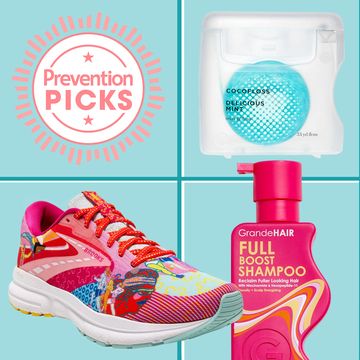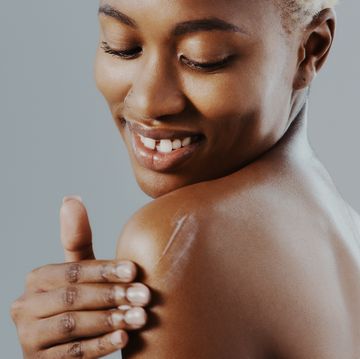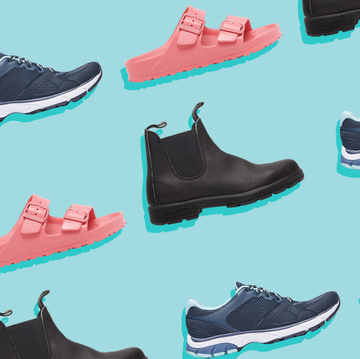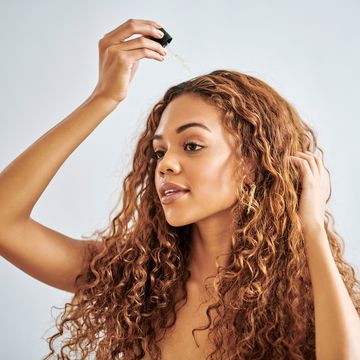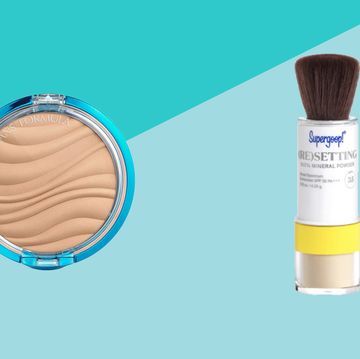Maybe you've started to reconsider your anti-filler stance lately, or perhaps you just want to know what the heck is up with all those fillers and injectables you keep hearing about (can they really be safe?). We've got the answers you've been looking for.
Unlike topical creams and serums, fillers can actually target the signs of aging deep beneath your skin. They can also help replace the youthful fullness that's slipped away due to age-related fat loss in your face, which can leave you with a sunken look, says Alexes Hazen, MD, associate professor of plastic surgery at NYU Langone Medical Center. Wary of unnatural results? Just make sure you and your dermatologist or surgeon keep this golden rule in mind: "The goal isn't to get rid of every crease or wrinkle on the face," says Julius Few, MD, director of the Few Institute for Aesthetic Plastic Surgery and clinical professor at the University of Chicago. "You're after a graceful, healthy appearance."
But with 22 FDA-approved fillers in existence, picking the right one that can handle your specific aging concerns is intimidating. Here's the low-down on everything related to fillers—including which best suits the aging issue that bugs you most.
What's in these fillers, anyway?
Made to rejuvenate the face by restoring volume, enhancing the shape of different areas, and plumping up wrinkles, fillers come in 6 different formulations: hyaluronic acid (HA), collagen, hydroxylapatite, poly-L-lactic acid, polymethylmethacrylate (PMMA), and fat:
1. Hyaluronic acid Hyaluronic acid (HA) naturally occurs in the body and plumps the skin when it binds with water. These fillers are sometimes spiked with an anesthetic called lidocaine to help reduce the pain factor. And their effects are reversible: If you're unhappy with results, your doctor can easily dissolve your HA filler by injecting an enzyme called hyaluronidase.
2. Collagen This protein plays a key role in supporting your skin's structure. Though collagen fillers were the first type of fillers available, their effects fade fastest—results last just three to four months, making them less popular than newer, longer-lasting choices on the market.
3. Hydroxylapatite Designed for moderate-to-severe wrinkles (like smile lines), hydroxylapatite is a mineral-like substance that naturally occurs in human bones and is suspended in a gel-like solution to create one specific filler: Radiesse. FDA-approved in 2006, Radiesse fills in wrinkles and stimulates the production of collagen in the body, and its effects last 12 to 18 months.
4. Poly-L-lactic acid This man-made material is what's in the filler Sculptra, which was approved by the FDA in 2009. It's intended to add lost volume back to the face, and it stimulates collagen production, says Hazen. You'll need two injections over a period of six months, you won't see results immediately (maybe not even for a few months), and it may be the most painful filler, she adds. That said, results can last anywhere from 18 to 24 months.
5. Polymethylmethacrylate (PMMA) Another man-made material (with a tongue-twisting name), PMMA beads are teeny bits of shatter-resistant plastic, which, when used in filler-form, are suspended in a gel-like formula that also contains collagen. These fillers are permanent and offer gradual but lasting results.
6. Fat Another permanent option, fat injections are the most invasive of all fillers. Your doctor will perform a liposuction procedure to remove fat from another part of your body (the stomach, for example), before processing the fat to remove any liquids and using the remaining pure fat for your injections. You'll see immediate results, but unlike with other fillers, you may have downtime, too: swelling and bruising in the injection site and where the fat was taken from are common. Another downside, says Hazen: though the injected fat adapts to its new location in the body, if you gain weight, the fat will grow in its relocated spot.
MORE: 10 Beauty Products You Should Never Use After 40
What are the risks?
Most filler treatments will have you in and out in less time than it takes to stream your favorite show—we're talking between 15 to 30 minutes. And though there's usually no downtime (applying makeup and going about your day afterward is A-okay), you may experience some redness, bruising, swelling, and itching. Not only that, but there's also a risk that a filler will cause a bluish skin discoloration and may possibly even form tiny bumps under the skin that are sometimes permanent, says Matthew Schulman, MD, a plastic surgeon in New York City. Also, know that there's a slight risk for infection, says Hazen.
While the pain related to fillers can range depending on the area being treated (lips and eyes may be more sensitive), a handful of fillers are formulated with an anesthetic to minimize pain. As for results, though you'll see them immediately (excluding Sculptra), they'll look even better once the filler has "settled" into place—typically one to two weeks after the treatment, says Schulman.
But the most important thing is to choose your doctor wisely. That means doing your homework. Make sure your doctor is certified in general plastic surgery and specializes in fillers. (Find MD's who fit the bill here). And if you can, ask for referrals from people you know and trust who've tried fillers themselves.
MORE: 6 Anti-Aging Products Under $20
What does "off label" mean?
"When a filler—or any drug for that matter—is approved by the FDA, it has to go through a lengthy process to show that it's safe and it does what it says it will," says Edwin Williams, MD, a New York-based facial plastic surgeon and president-elect of the American Academy of Facial Plastic and Reconstructive Surgery. This costly and generally slow-moving process gives the official go-ahead for the filler to be used for a specific purpose (like filling in wrinkles) in a specific area of your face (like around your mouth). So when an FDA-approved filler is used in an area not approved by the FDA, it's considered an "off-label use".
Which fillers work best for what?
The injectable: Bellafill
Best for: Erasing acne scars
How it works: One of the newest fillers to be approved by the FDA, and the only one that can take on this specific concern, this collagen injectable fills in and lifts the divots left behind by acne. Its combo of collagen gel, which provides volume, and PMMA microspheres that sustain the lifted effect and support the natural production of collagen in the body, make for lasting results. However, Bellafill won't work on deep, narrow scars. And, unlike other fillers, Bellafill requires a skin test to make sure you're not allergic to it, says Few.
Cost: $800 per treatment; 1-2 sessions are typically needed to see optimal results
How long it lasts: A year at minimum (it hasn't been clinically studied past 12 months)
The filler: Juvéderm Voluma XC (Voluma, for short)
Best for: Boosting your cheek volume
How it works: The hyaluronic acid (HA) filler was FDA-approved to plump the cheeks in 2013 and is considered the gold standard for this area, says Williams. Voluma is thicker than most fillers, so it gives sturdy support to the face, and is injected deeply into the skin next to the cheekbone, which allows it to lift the tissue above it, says Schulman. Since this filler is fairly new, it's important to find a board-certified dermatologist or plastic surgeon with experience using Voluma. Be sure to ask your doc how many times they've worked with Voluma in particular—they should have successfully used it on at least 50 people, Schulman advises. And remember: If you're not happy with the results, your doc can dissolve the HA filler with hyaluronidase, so you won't be stuck with too-cherubic cheeks.
Cost: $1,000 per syringe; 1 to 2 syringes are generally needed per treatment
How long it lasts: 14 to 16 months
MORE: Anti-Aging Contact Lenses?
The fillers: Perlane, Juvéderm Ultra Plus, Radiesse, or fat injections
Best for: Softening nasolabial folds. Each works differently depending on how deep the lines are, says Few: For mild to moderate wrinkles, he prefers Juvéderm Ultra, Belotero, or Restylane. For deeper wrinkles, he prefers Perlane, Juvéderm Ultra Plus, Radiesse, or fat injections.
How they work: The first group of fillers' small-to-medium particle size allows them to be placed more superficially for a smoother look, says Few, but they're not built to handle deeper lines, which the fillers in the latter group are. Luckily, since they're all approved by the FDA to be used in this way, working with your dermatologist to find the right match won't be hard.
Costs: Juvederm Ultra: $568; Belotero Balance: $300-$500; Restylane: $568; Perlane: $568; Juvederm Ultra Plus: $568; Radiesse: $635; Fat Injections: $1,682
How long they last: Juvéderm Ultra: 6 to 12 months; Belotero Balance: 6 to 12 months; Restylane: initial injections may last 6 months or more and reinjections may last 18 months or more; Perlane: initial injections may last 6 months or more and reinjections may last 18 months or more; Juvéderm Ultra Plus: 6 to 12 months; Radiesse: 12 months or more; Fat Injections: Results can last 5 years or more
MORE: 4 Things You Can Try Before Botox
The filler: Restylane Silk
Best for: Plumping lips
How it works: Another hyaluronic acid filler (paired with a super-fine needle, which minimizes bruising and swelling), Restylane Silk has only recently joined the elite FDA-approved club, in June of 2014. It can plump your lips and fill fine lines around the mouth. But take note: because your lips are sensitive, this one can be pretty painful, says Schulman. To minimize the pain, your doctor may apply a topical anesthetic cream or numb the nerves in your lips before taking a needle to the area.
Cost: $550
How long it lasts: 6 to 9 months
The injectable: Botox
Best for: Smoothing frown lines and crow's feet
How they work: While two other injectables, Xeomin and Dysport, are FDA-approved for frown lines, pros tend to favor the injectable Botox for the job. Botox reduces your ability to frown by temporarily paralyzing the muscle and also smooths wrinkles, explains Hazen. The FDA first approved it in the 1980s to treat spasms in the eyelids and misaligned eyes, but gave it the green light for use on between-the-brows wrinkles in 2002. Botox is also FDA-approved to relax the area around your eyes and smooth out the wrinkles. Apart from bruising, potential risks include a headache the following day, and, in rare cases, eyebrow or eyelid drooping. You'll generally see the full effect in 3 to 7 days. To avoid any chance of a frozen face, work with an experienced doctor who understands the look you're going for and will inject with a light hand.
Cost: $250-$500 for frown lines; $250-$350 for crow's feet
How long they last: 3 to 6 months
MORE: 6 Anti-Aging Beauty Products That Actually Make You Look Older







